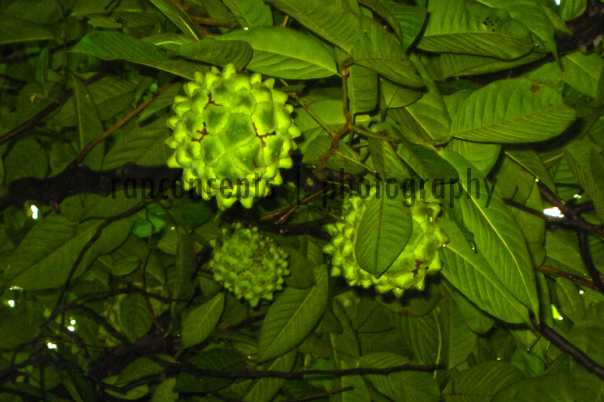This fruit might look strange to you, but never judge it by its outer appearance. May I describe this: it tastes like Guyabano, a fruit known for its cancer-killing capabilities. Its English name is “Sugar Apple” which is known in the Philippines as “Atis”.
I took this photo before harvesting them and taste for the very first time the fruit which was strange to me.
Science Facts:
Annona squamosa (also called sugar-pineapple or sweetsop) is a species of Annona native to the tropical Americas and widely grown in Colombia, El Salvador, India, Bangladesh, Pakistan and the Philippines. Its exact native range is unknown due to extensive cultivation, but thought to be in the Caribbean; the species was described from Jamaica.
It is a semi-evergreen shrub or small tree reaching 6–8 meters (20–26 ft) tall. The leaves are alternate, simple, oblong-lanceolate, 5–17 cm (2.0–6.7 in) long and 2–5 centimeters (0.79–2.0 in) broad. The flowers are produced in clusters of 3-4, each flower 1.5–3 cm (0.59–1.2 in) across, with three large petals and three minute ones, yellow-green spotted purple at the base.
The fruit is usually round, slightly pine cone-like, 6–10 cm (2.4–3.9 in) diameter and weighing 100–230 g (3.5–8.1 oz), with a scaly or lumpy skin. There are variations in shape and size. The fruit flesh is sweet, white to light yellow, and resembles and tastes like custard. The edible portion coats the seeds generously; a bit like the gooey portion of a tomato seed. Sugar-apple has a very distinct, sweet-smelling fragrance. The texture of the flesh that coats the seeds is a bit like the center of a very ripe guava (excluding the seeds). It is slightly grainy, a bit slippery, very sweet and very soft. The seeds are scattered through the fruit flesh; the seed coats are blackish-brown, 12–18 mm (0.47–0.71 in) long, and hard and shiny.
There are also new varieties being developed in Taiwan. The atemoya or “pineapple sugar-apple”, a hybrid between the Sugar Apple and the Cherimoya, is popular in Taiwan, although it was first developed in the USA in 1908. The fruit is similar in sweetness to the sugar apple but has a very different taste. Like the name suggests, it tastes like pineapple. The arrangement of seeds is in spaced rows, with the fruit’s flesh filling most of the fruit and making grooves for the seeds, instead of the flesh only occurring around the seeds. Unlike other Annona fruits, the Sugar Apple has segmented flesh. (Wikipedia)



I had these in Taiwan! I like them 🙂 They were mentioned in my post about the fruits I saw earlier this year from a Taiwanese Street Vendor (from street markets) here: http://ohsnapletseat.wordpress.com/2012/05/10/fruits-from-a-taiwanese-street-vendor .
Thanks for sharing!
-Tina from http://ohsnapletseat.wordpress.com
My curiosity was a factor…I really wondered what it taste…but now I guess I can be counted as one of those who admire this fruit. Stay in touch!
Thanks! I’ll follow you! While we’re on the topic of interesting fruit though, have you ever had rambutans? I just tried some for the first time last week. If you’ve ever had lychee’s they taste kind of similar but rambutans look super exotic: http://ohsnapletseat.wordpress.com/2012/10/15/a-very-hairy-fruit-rambutan. Have a nice day!
Oh yes! Rambutans are abundant here in the Philippines, particularly in Mindanao. I enjoy eating them. God bless!